Asus M5A99X EVO and Asus M5A97 EVO: two Simpler Mainboards for AMD Bulldozer

To study the design and functionality of the mainstream and entry-level chipsets for the AMD Bulldozer platform we decided to go with two mainboards from Asus: Asus M5A99X EVO and Asus M5A97 EVO, based on AMD 990X and AMD 970 chipsets respectively. In our today’s review we are going to compare them against one another as well as against the previously tested mainboards on the top Socket AM3+ core logic set.
We have already tested over half a dozen mainboards for AMD’s new Bulldozer processors. Coming from different developers, they are all top-of-the-line products featuring the most advanced Socket AM3+ chipset: AMD 990FX + AMD SB950. However, buying such a mainboard makes sense only if you are really going to use all of its capabilities, particularly the opportunity to build fast multi-GPU graphics subsystems. AMD’s 9 series chipsets have the same specs except for the number of PCI Express 2.0 lanes and their management. The senior chipset model allows using two graphics cards in full-speed PCI Express 2.0 x16 mode or four cards in x8 mode each. The midrange model supports two graphics cards simultaneously, both in x8 mode, whereas the junior model can work with one graphics card in x16 mode and does not allow to split those 16 lanes up.
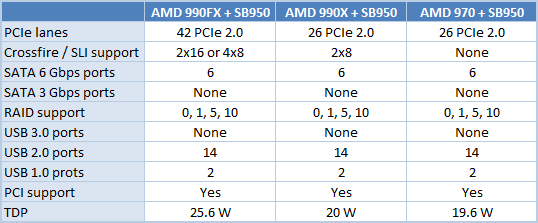
So if you plan to run no more than one graphics card, you may want to choose a mainboard with one of the less advanced AMD chipsets, i.e. AMD 990X or AMD 970. You won’t lose anything in functionality but can save some money.
Well, we used to reason in the same way when we tested mainboards with AMD’s 8 series chipsets, but regular mainboards turned out to be inferior to flagship models both in features and in overclockability then, the only exception being Gigabyte’s products. We are not that optimistic now. Talking about specific brands, ASUS mainboards seem to be the best choice for AMD’s Bulldozer CPUs, especially in terms of overclocking. Therefore, we are going to check out the capabilities of the midrange (AMD 990X) and junior (AMD 970) chipsets using M5A99X EVO and M5A97 EVO mainboards, respectively. We’ll compare them with each other as well as with earlier-tested mainboards based on the senior chipset for the Socket AM3+ platform.
Packaging and Accessories
The two mainboards come in almost identical standard-sized boxes. You can find a picture of the product, a brief list of its technical characteristics and a description of its features on the back of the box.
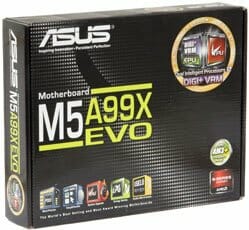
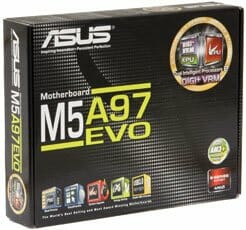
The mainboard is placed in an antistatic pack. It’s separated from the rest of the box contents with a cardboard partition. The accessories to the ASUS M5A99X EVO include the following:
- Four SATA cables with L-shaped metal connector locks;
- A flexible bridge for two-way Nvidia SLI graphics configurations;
- I/O Shield for the back panel;
- “Asus Q-Connector” set including adapters for easy connection of the system case front panel buttons and indicators and a USB port;
- User manual;
- DVD disk with software and drivers;
- “Powered by Asus” sticker for the system case.
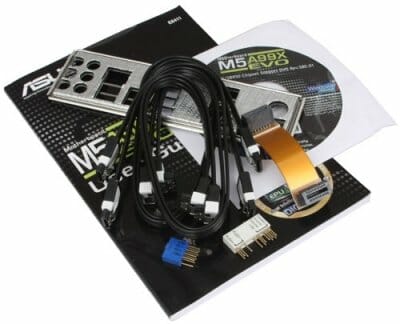
The M5A97 EVO comes with the same accessories with one exception. There is no bridge for connecting two graphics cards because the mainboard’s chipset doesn’t allow splitting PCI Express lanes up between multiple graphics slots.
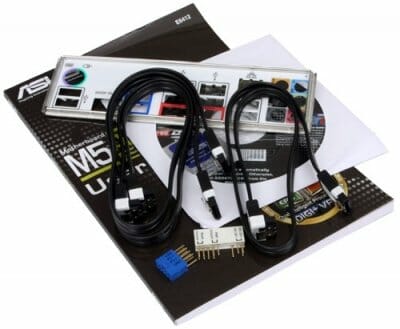
PCB Design and Functionality
The two mainboards seem to be almost identical at first sight, but there are actually quite a lot of differences on closer inspection.
Compared to ASUS’s flagship AMD-based mainboards, the CPU voltage regulator has been simplified from 8+2 to 6+2 design. The cooling systems look identical on both mainboards, but the North Bridge heatsink is secured with screws on the M5A99X EVO and connected with a heat pipe to the CPU VRM heatsink. The junior mainboard’s heatsinks are fastened with spring-loaded plastic locks and lack any heat pipes.
The M5A97 EVO has six SATA 6 Gbit/s ports, two of which are placed aside of the others. The M5A99X EVO, on its part, also has six SATA 6 Gbit/s ports thanks to the AMD SB950 South Bridge but complements them with two SATA 3 Gbit/s ports based on a JMicron JMB362 controller.
It’s in the expansion slot area that we see the biggest differences between the two models. They are due to the different chipsets, of course. The M5A99X EVO is equipped with one PCI, two PCI Express 2.0 x1 and three PCI Express 2.0 x16 slots. It supports one graphics card at full x16 speed or two graphics cards (in CrossFireX or SLI mode with up to 4 GPUs) at x8 speed each. The third x16 slot is connected to four PCIe lanes provided by the South Bridge. The junior mainboard has two PCI, two PCI Express 2.0 x1 and two PCI Express 2.0 x16 slots but the top slot is the only one to work at full speed. The bottom slot is x4. The mainboard supports Quad-GPU CrossFireX but not SLI.
Here is the complete list of all ports and connectors on the back of our ASUS M5A99X EVO:
- PS/2 connector for keyboard or mouse;
- Eight USB 2.0 ports, six more can be connected to three onboard pin-headers;
- Optical S/PDIF and six analogue audio-jacks provided by eight-channel Realtek ALC892 codec;
- IEEE1394 (FireWire) port implemented via VIA VT6308P controller, the second port is available as onboard pin-connector;
- Two eSATA 3 Gbps port implemented via JMicron IMB362 controller, one of which is Power eSATA (green connector). The second controller like that adds support for another two internal SATA ports;
- Two USB 3.0 ports (blue connectors) implemented via ASMedia ASM1042 controller, second controller like that provides an additional internal pin-connector for two more USB 3.0 ports;
- A local network port (network adapter is built on Gigabit Realtek RTL8111E controller).
The mainboards’ back panels differ a lot. Take a look at the M5A97 EVO’s:
The selection of I/O ports is almost the same, though. They are just arranged in a different way. The single difference is that the junior model’s back panel offers two ordinary eSATA 3 Gbit/s ports whereas the senior model has one port of the Power eSATA variety.
The mainboards both have a number of features typical of other ASUS products such as the MemOK! button that helps start the computer up in case of some memory-related problems. The graphics slots are equipped with handy Q-Slot latches whereas the memory slots have Q-DIMM latches on one side only. In case of some problems, the Q-LED indicators report the step at which the boot-up process has been halted. The TPU switch can be used to overclock the CPU automatically while the EPU switch enables power-saving operation modes.
The M5A99X EVO offers five fan connectors, two of which are of the 4-pin variety. The junior model has two 3-pin and two 4-pin fan connectors. The mainboards can regulate the speed of each connected fan depending on temperature, except for the fan marked as Power FAN.
For your reference all mainboards’ specifications have been summed up in the following table
BIOS Functionality
We’ve already described ASUS’s very handy implementation of the UEFI standard in our previous reviews. The ASUS EFI BIOS interface offered a few special features and had a ROG-style design for the ASUS Crosshair V Formula model, but you won’t find any differences between the M5A99X EVO and M5A97 EVO on one part and the ASUS Sabertooth 990FX on the other, for example. The two mainboards having the same BIOS options, we will use the M5A99X EVO in the following description.
By default the BIOS opens up in EZ Mode which gives you a lot of information but offers almost no user-defined options. You can only learn some basic system specs and monitor a few parameters, choose between high-performance and energy-saving operation modes, and define the boot device order by dragging the icons with your mouse.z
You can make the BIOS open in Advanced Mode. In this case you will see the familiar Main section.
The BIOS interface is available in multiple languages, which may be handy for non-English speakers.
Most of the overclocking-related options are collected in the Ai Tweaker section. The new BIOS interface may seem unusual but its structure and setup options are quite recognizable as those of ASUS’s older BIOS. There are a lot of new options, though, which are mostly related to power supply and the new digital power system called DIGI+.
You can control ASUS’s exclusive power-saving technologies right here. One of them allows changing the number of active phases in the CPU voltage regulator depending on load. CPU Load Line Calibration can now be not only enabled or disabled but also set to a certain level (it helps counteract the voltage drop occurring on the CPU under load). You don’t have to move to the monitoring section to check out the current levels of voltages as they are shown right next to each voltage-affecting parameter.
Some of the setup options are available in individual subsections in order not to clutter the main section. One such subsection contains memory timings, for example.
The options of the Advanced section should be familiar to you and their names are self-descriptive. We can only note that SATA disks work in AHCI mode on ASUS mainboards by default.
The CPU Configuration subsection reports you basic information about the CPU and allows to control some CPU-related technologies. Take note that all of the power-saving technologies are enabled by default. There is an option called HPC Mode that prevents the CPU from lowering its clock rate under load.
The Monitor section is where you can check out the current temperatures, voltages and fan speeds. You can select the speed regulation mode for the CPU and system fans: Standard, Silent or Turbo. You can also set them up manually (except for the Power Fan).
System startup options can be found in the Boot section. It’s here that you can change the start mode from EZ to Advanced.
Next goes the Tools section.
The integrated BIOS update tool called EZ Flash 2 is perhaps the handiest and most functional among the utilities of its kind. It has changed with the transition to EFI BIOS. For example, the current firmware version is saved into the root directory of the connected drive by default.
Like on mainboards from many other brands, we can now see the information written into the memory modules’ SPD unit.
ASUS mainboards allow you to store and load up to eight profiles with full BIOS settings. Each profile can be given a descriptive name.
The Exit section goes last. It allows you to save your changes, load default BIOS settings, or switch back to EZ Mode.
New ASUS EFI BIOS is an excellent example of how the capabilities of the old BIOS can be expanded without making it harder to use. We guess the biggest problem that this BIOS presents is the sheer abundance of settings. However, the mainboard sets most of them at optimal values by default, so you can leave everything as it is and have your system running smoothly.
There are but few minor problems and inconveniences we can note. For example, the profiles with settings do not remember your turning off the startup picture and the current firmware is saved only to the disk’s root directory rather than into any folder you want.
Testbed Configuration
We carried out our tests on a testbed that included the following components:
- Mainboards:
- Asus M5A99X EVO rev.1.01 (Socket AM3+, AMD 990X/SB950, BIOS version 0810);
- Asus M5A97 EVO rev.1.01 (Socket AM3+, AMD 970/SB950, BIOS version 0810);
- AMD FX-8150 CPU (3.6 GHz, Zambezi (Bulldozer), AM3+);
- 2 x 2048 MB DDR3 SDRAM Patriot Extreme Performance Viper II Sector 5 Series PC3-16000, PVV34G2000LLKB (2000 MHz, 8-8-8-24 timings, 1.65 V voltage);
- MSI N570GTX-M2D12D5/OC graphics card (Nvidia GeForce GTX 570, GF110, 40 nm, 786/4200 MHz, 320-bit GDDR5 1280 MB);
- Kingston SSD Now V+ Series (SNVP325-S2, 128 GB);
- Scythe Mugen 2 Revision B (SCMG-2100) CPU cooler and an additional 80×80 mm fan for cooling of the area around the CPU socket during overclocking experiments;
- ARCTIC MX-2 thermal interface;
- CoolerMaster RealPower M850 PSU (RS-850-ESBA);
- Open testbed built using Antec Skeleton system case.
We used Microsoft Windows 7 Ultimate SP1 64 bit (Microsoft Windows, Version 6.1, Build 7601: Service Pack 1) operating system, Nvidia GeForce Driver 280.26 graphics card driver.
Operational and Overclocking Specifics
We had no problems building our test configurations with the M5A99X EVO and M5A97 EVO except that we got samples with older BIOS versions which did not support the Socket AM3+ Bulldozer series. So, we had to first install an old Socket AM3 processor to update the firmware and then the mainboards could start up with the new AMD FX-8150. Both mainboards worked with the new CPU correctly, enabling Turbo and power-saving technologies. The frequency and timings of the memory modules were set up at 1067 MHz and 7-7-7-20-1T, just as written in their SPD. However, if the EPU Power Saving Mode (an exclusive power-saving technology of ASUS mainboards) was enabled, the timings were increased to 9-9-9-24-1T. Moreover, they remained too high even after we disabled that technology. We could only bring the timings back to their defaults by loading the optimal BIOS settings or a profile where the EPU Power Saving Mode option hadn’t been changed.
This problem was observed with both mainboards, so we suspect it to be present with the rest of ASUS’s new Socket AM3+ products, too. By the way, the ASUS Crosshair V Formula defaults to memory timings of 9-9-9-24-1T, too, and we benchmarked it at such settings, which affected its performance in certain applications. It turns out that the mainboard may have selected correct timings at first, but spoiled them after our enabling EPU Power Saving Mode. The latter can be turned off not only in the mainboard’s BIOS but also with the hardware EPU switch. The timings will be normal then until you change anything in BIOS settings. Hopefully, the manufacturer will do something about this problem to make its mainboards both fast and energy-efficient without making the user choose between the two.
As for overclocking, the M5A99X EVO could easily clock our CPU at its highest frequency of 4.5 GHz. We only had to increase the CPU voltage higher than usual. The memory modules worked correctly at 1867 MHz. The mainboard has a slightly overclocked base frequency, so the effective CPU and memory clock rates are somewhat higher than the mentioned numbers.
We had had no problems overclocking our AMD FX-8150 to 4.5 GHz with every ASUS mainboard, but the M5A97 EVO was the first exception. We couldn’t make it stable even at a CPU clock rate of 4.4 GHz. MSI’s 990FXA-GD80 hadn’t been able to clock our CPU at 4.5 or 4.4 GHz, either, so we tried to change the frequency multiplier in case these mainboards didn’t like the one we used. We increased the base clock rate to 204 MHz and set the multiplier at x21.5, yet the M5A97 EVO wasn’t stable anyway. We tried to turn various power-related technologies on and off but had to eventually limit ourselves to 4.3 GHz. The good news is that we could increase the North Bridge clock rate to 2400 MHz and the memory frequency to 1867 MHz.
Overclocking often serves as a means of raising one’s self-esteem or demonstration of one’s abilities and skills. However, overclocking for the sake of overclocking doesn’t have much practical value. In our opinion, if you are willing to accept certain risks connected with overclocking, it should reward you by higher performance, or shorter computational time. Overclocking may deliver some quality improvements, allowing one to play games at higher screen resolution or with higher image quality settings. However, at the same time the overclocked system should remain stable and comfortable to work with. It makes no sense to waste a ton of energy by making your CPU ran at high speed and voltage, when it is totally uncalled for. Therefore, when we overclock our systems, we make sure that it could be used permanently in such mode. For the same reason we do not disable any features, e.g. onboard controllers, and try to keep the CPU’s power-saving features up and running. The ASUS mainboards were overclocked in this manner, too. When idle, they lowered the CPU’s voltage and frequency multiplier to save power.
Performance Comparison
As usual, we are going to compare the mainboards speeds in two different modes: in nominal mode and during CPU and memory overclocking. The first mode is interesting because it shows how well the mainboards work with their default settings. It is a known fact that most users do not fine-tune their systems, they simply choose the optimal BIOS settings and do nothing else. That is why we run a round of tests almost without interfering in any way with the default mainboard settings. For comparison purposes we also included the results from the recently tested flagship Bulldozer mainboards from Asus, Gigabyte and MSI, as well as Asus Sabertooth 990FX and Biostar TA990FXE. All mainboards worked in identical conditions and only two mainboards had different memory timings: Asus Crosshair V Formula mainboard by default set the memory timings at 9-9-9-24-1T, Gigabyte GA-990FXA-UD7 – at 7-7-7-20-2T and only on Asus Sabertooth 990FX, Biostar TA990FXE and MSI 990FXA-GD80 mainboards we saw the correct timings from the memory modules SPD – 7-7-7-20-1T.
The results are sorted out in descending order on the diagrams and the results of Asus M5A99X EVO and Asus M5A97 EVO are marked with darker color for your convenience.
We used Cinebench 11.5. All tests were run five times and the average result of the five runs was taken for the performance charts.
We have been using Fritz Chess Benchmark utility for a long time already and it proved very illustrative. It generated repeated results, the performance in it is scales perfectly depending on the number of involved computational threads.
A small video in x264 HD Benchmark 4.0 is encoded in two passes and then the entire process is repeated four times. The average results of the second pass are displayed on the following diagram:
We measured the performance in Adobe Photoshop using our own benchmark made from Retouch Artists Photoshop Speed Test that has been creatively modified. It includes typical editing of four 10-megapixel images from a digital photo camera.
In the archiving test a 1 GB file is compressed using LZMA2 algorithms, while other compression settings remain at defaults.
Like in the data compression test, the faster 16 million of Pi digits are calculated, the better. This is the only benchmark where the number of processor cores doesn’t really matter, because it creates single-threaded load.
Since we do not overclock graphics in our mainboard reviews, the next diagram shows only CPU tests from the 3DMark11 – Physics Score. This score is obtained in a special physics test that emulates the behavior of a complex gaming system working with numerous objects:
We use FC2 Benchmark Tool to go over Ranch Small map ten times in 1920×1080 resolution with high image quality settings in DirectX 10.
Resident Evil 5 game also has a built-in performance test. Its peculiarity is that it can really take advantage of multi-core processor architecture. The tests were run in DirectX 10 in 1920×1080 resolution with high image quality settings. The average of five test runs was taken for further analysis:
Similar mainboards often deliver the same performance if you set them up identically, and we can see that now. The difference is within 1% in most of the tests. It’s only in the last gaming test that the ASUS M5A99X EVO falls behind by 3% for some reason.
By the way, we have been using Resident Evil 5 for testing for a while now. It has a very handy integrated benchmark that scales well depending on the number of CPU cores.
But it’s only recently that we’ve discovered one of its visual features: when the frame rate is below 90 fps, the results are displayed against a different background.
We had used such settings and processors that we had never seen such a low frame rate before. The new Bulldozer is the first CPU to fail to reach 90 fps at the default clock rate. It’s especially sad that we’ve got the flagship AMD FX-8150.
Now let’s run the same tests with the CPU and memory overclocked. You can see the difference in the system parameters in the following table:
We can’t confuse the results of the two ASUS mainboards here. The junior model overclocked our CPU to only 4.3 GHz, which is 200 MHz lower than most of the other mainboards, and this difference explains why it’s behind by about 4%. The M5A97 EVO is as fast as the MSI 990FXA-GD80, though, as both have the same CPU frequency.
Power Consumption
We performed our power consumption measurements using an Extech Power Analyzer 380803. This device is connected before the PSU and measures the power draw of the entire system (without the monitor), including the power loss that occurs in the PSU itself. In the idle mode we start the system up and wait until it stops accessing the hard disk. Then we use LinX to load the CPU. For a more illustrative picture there are graphs that show how the computer’s power consumption grows up depending on the number of active execution threads in LinX (both at the default and overclocked system settings). The mainboards are sorted in alphabetical order on the diagrams.
We often point out that on many mainboards certain power-saving technologies are disabled by default. This time we decided to illustrate our discontent with this issue with numbers. We measured the power consumption of test systems in idle mode with default settings and then with all power-saving technologies manually enabled.
As opposed to ASUS’s flagship products, the Cool’n’Quiet and C1E technologies work on both mainboards by default. It turned out that enabling the exclusive EPU technology and the dynamic regulation of the number of active phases in the CPU voltage regulator did not affect the power consumption of the mainboards. We can’t judge these technologies basing on the test in idle mode, though. So, we carried out a range of tests at different loads with the M5A97 EVO.
It’s Cool’n’Quiet, C1E and C6 features that help lower the mainboard’s power consumption in idle mode. They are turned on by default and ASUS’s exclusive technologies do not affect the mainboard’s idle power draw which is 82 watts. However, they do have a positive effect when the computer is running some applications. With these technologies turned on, the power consumption at eight execution threads is only 222 watts, which is even lower than at four threads with the exclusive power-saving technologies turned off (228 watts).
We want to remind you that we carry out our power consumption tests at the default settings, therefore the consumption of the ASUS mainboards is higher in the next diagram than with enabled CPU Power Phase Control and EPU. Overall, the M5A97 EVO is average in terms of power draw while the M5A99X EVO is more economical than its opponents under load.
On the other hand, the same M5A99X EVO has the highest power consumption when overclocked because we had to increase the CPU voltage higher than usual. The M5A97 EVO looks better than the other ASUS mainboards but only because it couldn’t overclock our CPU to its maximum frequency and had a lower CPU voltage. It should be compared with the MSI 990FXA-GD80 which clocks the CPU at 4.3 GHz too, but is more economical in every mode.
Conclusion
ASUS’s M5A99X EVO and M5A97 EVO mainboards are high-quality products which only differ from their top-end cousins in the variety of additional controllers and expansion slots. Their functionality is board enough and includes all modern interfaces: USB 3.0, SATA 6 Gbit/s, eSATA and IEEE1394 (FireWire). So if you do not plan to use a lot of graphics cards, each of them can be a good choice. The only downside is that the overclocking potential of the junior chipsets is lower than that of the flagship AMD 990FX. And we’re talking about ASUS mainboards which have turned out to be the best choice for overclocking the new Bulldozer series. The results are going to be even more disappointing with other mainboards, we guess.
Anyway, we have no doubt about the bright market future of the M5A99X EVO and M5A97 EVO mainboards. People who look for highest performance prefer Intel whereas AMD users have other priorities. The AMD platform is quite good for building an affordable computer with acceptable performance and these ASUS mainboards cost much less than their flagship counterparts.